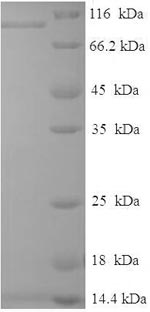The recombinant human RAF1 protein, engineered with an N-terminal 6xHis-SUMO tag, is expressed using an E. coli expression system. The RAF1 gene fragment (1-648aa) is first co-cloned into a suitable expression vector with the 6xHis-SUMO tag gene and then transformed into competent E. coli cells. After induction with IPTG to trigger protein expression, the cells are harvested and lysed to obtain the targeted proteins. The recombinant RAF1 protein is purified using affinity chromatography. The purified RAF1 protein is analyzed for purity via SDS-PAGE, which typically shows a purity greater than 90%, ensuring the protein is suitable for downstream applications.
The human RAF1 (C-Raf) is a critical component of the MAPK signaling pathway. This pathway is essential for various cellular processes, including proliferation, differentiation, and survival. RAF1 is a serine/threonine kinase activated by the small GTPase Ras, which is itself stimulated by growth factors, hormones, and cytokines [1-4]. Upon activation, RAF1 phosphorylates and activates MEK, which subsequently activates ERK, leading to a cascade of downstream signaling events that influence gene expression and cellular responses [5-7].
Excessive or prolonged activation of RAF1 can lead to adverse cellular outcomes, including apoptosis or uncontrolled cell division [8][9]. Recent studies have also highlighted the role of RAF1 in crosstalk with other signaling pathways, such as the PI3K/Akt pathway, which further complicates its function in cancer biology [2][10]. Understanding the multifaceted roles of RAF1 and its interactions within signaling networks is crucial for developing targeted therapies aimed at inhibiting its activity in cancer treatment [11][12].
References:
[1] M. Garnett and R. Marais, Guilty as charged, Cancer Cell, vol. 6, no. 4, p. 313-319, 2004. https://doi.org/10.1016/j.ccr.2004.09.022
[2] Q. Li, Z. Li, T. Luo, & H. Shi, Targeting the pi3k/akt/mtor and raf/mek/erk pathways for cancer therapy, Molecular Biomedicine, vol. 3, no. 1, 2022. https://doi.org/10.1186/s43556-022-00110-2
[3] R. Galuppo, D. Ramaiah, O. Ponte, & R. Gedaly, Molecular therapies in hepatocellular carcinoma: what can we target?, Digestive Diseases and Sciences, vol. 59, no. 8, p. 1688-1697, 2014. https://doi.org/10.1007/s10620-014-3058-x
[4] V. Balan, D. Leicht, J. Zhu, K. Balan, A. Kaplun, V. Singh‐Gupta, et al. Identification of novel in vivo raf-1 phosphorylation sites mediating positive feedback raf-1 regulation by extracellular signal-regulated kinase, Molecular Biology of the Cell, vol. 17, no. 3, p. 1141-1153, 2006. https://doi.org/10.1091/mbc.e04-12-1123
[5] C. Bondzi, S. Grant, & G. Krystal, A novel assay for the measurement of raf-1 kinase activity, Oncogene, vol. 19, no. 43, p. 5030-5033, 2000. https://doi.org/10.1038/sj.onc.1203862
[6] H. Park, S. Hwang, & K. Baek, Usp7 regulates the erk1/2 signaling pathway through deubiquitinating raf-1 in lung adenocarcinoma, Cell Death and Disease, vol. 13, no. 8, 2022. https://doi.org/10.1038/s41419-022-05136-6
[7] K. Yeung, P. Janosch, B. McFerran, D. Rose, H. Mischak, J. Sedivy, et al. Mechanism of suppression of the raf/mek/extracellular signal-regulated kinase pathway by the raf kinase inhibitor protein, Molecular and Cellular Biology, vol. 20, no. 9, p. 3079-3085, 2000. https://doi.org/10.1128/mcb.20.9.3079-3085.2000
[8] J. Chen, K. Fujii, L. Zhang, T. Roberts, & H. Fu, Raf-1 promotes cell survival by antagonizing apoptosis signal-regulating kinase 1 through a mek–erk independent mechanism, Proceedings of the National Academy of Sciences, vol. 98, no. 14, p. 7783-7788, 2001. https://doi.org/10.1073/pnas.141224398
[9] S. Jin, Y. Zhuo, W. Guo, & J. Field, P21-activated kinase 1 (pak1)-dependent phosphorylation of raf-1 regulates its mitochondrial localization, phosphorylation of bad, and bcl-2 association, Journal of Biological Chemistry, vol. 280, no. 26, p. 24698-24705, 2005. https://doi.org/10.1074/jbc.m413374200
[10] D. Reverter, D. Matallanas, G. Weitsman, C. Preisinger, T. Ng, & W. Kölch, Proapoptotic kinase mst2 coordinates signaling crosstalk between rassf1a, raf-1, and akt, Cancer Research, vol. 70, no. 3, p. 1195-1203, 2010. https://doi.org/10.1158/0008-5472.can-09-3147
[11] D. Ritt, M. Abreu-Blanco, L. Bindu, D. Durrant, M. Zhou, S. Specht, et al. Inhibition of ras/raf/mek/erk pathway signaling by a stress-induced phospho-regulatory circuit, Molecular Cell, vol. 64, no. 5, p. 875-887, 2016. https://doi.org/10.1016/j.molcel.2016.10.029
[12] H. Shi, X. Kong, A. Ribas, & R. Lo, Combinatorial treatments that overcome pdgfrβ-driven resistance of melanoma cells to v600eb-raf inhibition, Cancer Research, vol. 71, no. 15, p. 5067-5074, 2011. https://doi.org/10.1158/0008-5472.can-11-0140




